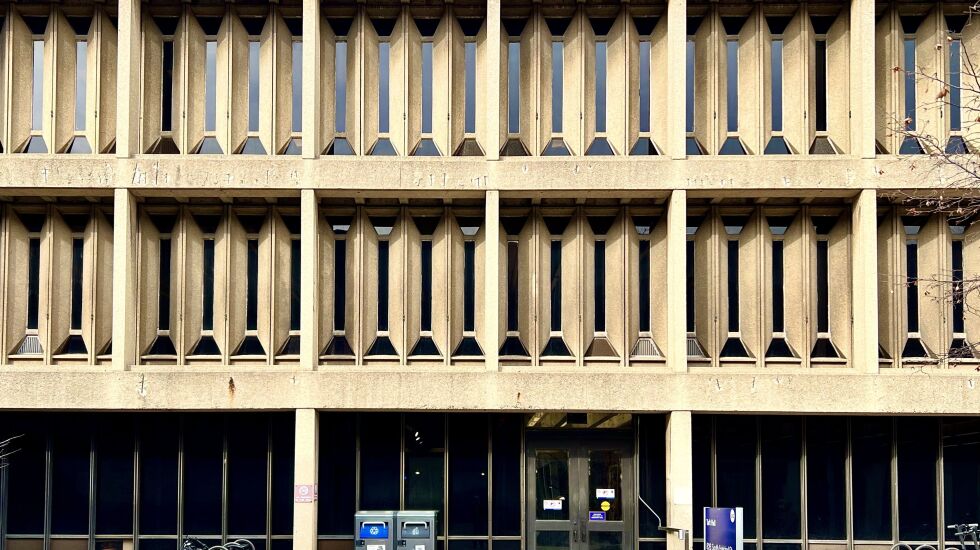A preservation group’s annual list of “most endangered” sites ranges from two early skyscrapers on State Street to reminders of Chicago’s industrial past.
The annual list from Preservation Chicago leads off with the Century Building at 202 S. State and the Consumers Building at 220 S. State, both dating from the early 20th century. The group has waged a public campaign to persuade the buildings’ owner, the federal government, to not tear them down.
The list goes on to include less-prominent buildings, including some many Chicagoans would overlook and might not think merit saving. The list includes the empty Continental Can Co. building at 3815 S. Ashland Ave. and the vacant and defaced Damen Silos at 2860 S. Damen Ave.
Ward Miller, executive director of Preservation Chicago, said the sites represent links to Chicago’s industrial past.
“This is a list that appeals to a broader audience,” Miller said. He said it challenges Chicagoans to look become personal tastes and consider the design and historical significance of the properties.
The group’s new rescue priorities were issued Wednesday during an event at the Chicago Architecture Center. Miller said it is the 20th year the group has issued a “most endangered list” in hopes of generating public support for preservation.
Miller said the group typically narrows each list from 70 to 90 suggestions submitted by the public, staff and board members.
The Century and Consumers buildings have made the list in three prior years. The federal government has appropriated $52 million to raze them, calling them a security risk for the abutting Dirksen Federal Building.
But the buildings are listed with the National Trust of Historic Places, so the government is holding hearings about possible alternatives to taking them down. Miller has argued that organizations could use the buildings as a repository for archives. Such use would enhance security for the federal complex in Chicago while razing the buildings worsens it, Miller has argued.
The Century Building opened in 1915 and was designed by Holabird & Roche. The Consumers Building opened in 1913 and was the work of Jenney, Mundie & Jensen.
The other buildings on the group’s 2023 list:

Terra cotta buildings throughout Chicago
Designed by various architects between the 1890s and 1940s, they range from notable skyscrapers to small neighborhood buildings. Many are deteriorating or could fall victim to development pressures. Terra cotta cladding became popular after the Chicago Fire of 1871 as cheap fireproof material and could be molded for ornamentation. Many buildings occupy prominent corners on commercial streets.

Jeffery Theater Building and Spencer Arms Hotel
7054 S. Jeffery Blvd. and 952 E. 71st St.
Designed by William P. Doerr in 1924, they anchored a commercial district, but the theater closed in 1976 and its auditorium was demolished. The façade and lobby survive. The buildings occupy about 25% of a potential development site and could be incorporated into a new entertainment district.

The Warehouse
206 S. Jefferson St.
The building was designed by Vernon W. Behel in 1906 and 1917. Nightlife entrepreneur Robert Williams bought it in 1975 and, with disk jockey Frankie Knuckles, turned it into a center for a new genre called “house music” that spread around the globe. The club was especially popular with LGBTQ African Americans.

Taft Hall at the University of Illinois Chicago
826 S. Halsted St.
The 1965 building is a remnant of Walter Netsch’s original design for the campus. It’s an example of Brutalist architecture that emphasizes basic building materials over decoration. The university has been recladding similar buildings in glass.

Werner Brothers Storage Building
7613 N. Paulina St.
The building, designed in 1921 by George S. Kingsley, was built when storage companies sought to create distinctive architecture and has intricate terra cotta treatment. Plans have been floated to replace it in Rogers Park with a transit-oriented development, but federal tax credits could be used for its preservation for affordable housing.

Continental Can Co.
3815 S. Ashland Ave.
The building, designed in 1920 by Samuel Scott Joy, has an eye-catching tower and is a visual anchor of the Central Manufacturing District. Key elements of the building could be part of an adaptive reuse. Many of the district’s historic buildings have been lost.
Damen Silos
2860 S. Damen Ave.
The grain silos are a monumental landmark for Chicago’s connections to agricultural markets. Civil engineer John Metcalf designed the silos which were erected in 1906. The state has sold them and its surrounding 23 acres to Michael Tadin Jr. and family. Tadin owns MAT Asphalt, the target of complaints about pollution in McKinley Park. He plans to demolish the silos as a safety hazard.

Fisk Power Station
1111 W. Cermak Road
Historic for its advances in steam engine turbines, the now-closed site generated electricity with output and efficiency to power the city’s growth. Shepley, Ruan and Coolidge designed the station in 1903. It’s part of a 50-acre potential development site.







